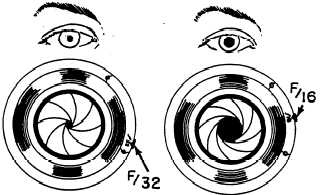Shutter Release Button
The shutter release button opens the shutter and
initiates the exposure.
Shutter Speed Dial
The shutter speed dial indicates optional shutter
speeds and sets the length of time the shutter remains
open during an exposure. Shutter speeds are indicated
in fractions of a second; for example, 60 = 1/60 of a
second (also expressed as 1/60"). The higher the number
on the dial, the faster the shutter speed and the shorter
the exposure.
ISO Indicator
The ISO (International Standards Organization)
indicator allows you to compensate for the particular
“speed” of your film. For example, if you are shooting
black-and-white film with an ISO of 400, you will set
your ISO indicator to 400. The higher the ISO, the more
light sensitive the film.
Aperture Control
The aperture control is a ring around the lens with
a scale listing aperture numbers (2.8, 3.5, 4, 5.6, etc.).
These numbers are also known as “f/stops.” The ring
sets the f/stop on the lens to control the amount of light
entering the lens.
Film Rewind Knob
The film rewind knob is used to rewind the film into
the cassette (film canister), to tighten slack in loaded
film and to open the back of the camera. You turn the
knob in the direction of the arrow to rewind the film, and
lift it to open the back of the camera.
LENSES AND APERTURES
As noted previously, most 35mm SLRs have
interchangeable lenses. The “final length” of a lens is
the distance from the optical center of the lens to the
final plane (film plane) when the camera is focused
upon an object at itifinity. A 50mm final-length lens is
considered the “normal” lens because when you look
through the viewfinder, objects appear at their
approximate normal size. A smaller than normal focal
length (such as 28mm) means a wider angle of view. A
longer than normal final length (such as 135mm) is a
telephoto lens. Focal length affects film image size.
11-6
Figure 11-5.—Comparison of the iris diaphragm of a camera
lens to the iris of the human eye.
The f/stop (aperture) ring controls the amount of
light passing through the iris diaphragm of the lens and
striking the film. The higher the f/stop number, the
smaller the amount of light allowed to enter the camera
lens. This principle works in the same manner as the iris
of the human eye (fig. 11-5).
OPERATING THE 35MM SLR CAMERA
LEARNING OBJECTIVE: Determine the
proper operating procedures for the 35mm SLR
camera.
The components of a 35mm SLR camera are of little
consequence if you do not know how to use them
together. In this section, you will learn how to perform
the following functions:
l
l
l
l
l
l
l
l
l
Loading
Holding the camera
Focusing the camera
Setting the film speed
Activating the light meter
Setting the shutter speed
Setting the aperture control
Shooting the picture
Unloading the film
LOADING
You should load the camera in subdued light (not
direct sunlight) and use the following method:

